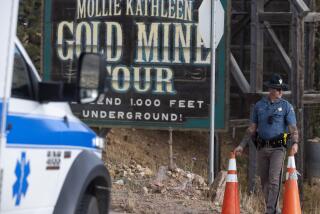Fallen Rock Slab Keeps Tunnel Machine Idle
- Share via
Despite assurances last week that a giant subway tunneling machine trapped under the Santa Monica Mountains for six weeks had finally been freed and would resume work, Metro Rail officials said Monday that a 10-foot slab of rock fell on it during the weekend--putting it out of action again.
The 300-foot-long machine has been lodged tight in “squeezing ground” 220 feet below Fredonia Street in Cahuenga Pass since it was allowed to stand idle for four days over the Fourth of July weekend. Metro Rail officials’ embarrassment over the mishap has grown as the weeks have passed.
At a meeting late Monday morning of the construction committee of the Metropolitan Transportation Authority directors, the agency’s deputy construction chief, John Adams, infuriated at least two board members by stating that he did not know whether tunneling would resume that day as promised.
“Our construction managers should be responsible and knowledgeable enough to answer simple questions,” said committee vice chair Vivien Bonzo, expressing her frustration in an interview after the meeting.
“This is the very thing that creates our concern in them.”
Added Bonzo, who owns an Olvera Street restaurant: “I try to hold them to the same standards as my busboys, and they haven’t met that standard.”
MTA spokeswoman Andrea Greene said a slab of rock had fallen on the roof of the tunnel boring machine’s shield “late Saturday or early Sunday” as workers dug around it to clear space to make a modification.
Greene said the rock--which measured 10 feet long by 2 feet wide by 2 feet thick--did not damage the shield. She said miners will need until the end of the week, however, to remove the debris and make mechanical changes to the machine.
MTA project manager Charles Stark has said that the tunneling machine became stuck when miners took four days off to celebrate Independence Day, and returned to discover they had parked it in a zone of “squeezing ground.” In such zones of heavily faulted rock, he said, “stored energy” compresses the ground into a tunnel--shrinking its diameter.
On Sunday, The Times reported that inspection reports filed by the MTA’s construction management consultants showed that the tunnel had been shrinking and suffering cave-ins for at least three weeks prior to the July 4 weekend. Independent mining experts said this should have alerted the firm digging the tunnel--Traylor Bros./Frontier-Kemper--that the ground was coming in on the machine.
The inspection reports also noted that steel ribs supporting the tunnel were extremely hard to install because the hole was smaller than designed.
The Times also reported that a panel of MTA construction executives and engineering consultants had allowed the contractor, as conditions warranted, to substitute weaker 4-inch-wide tunnel support ribs for 6-inch-wide ribs originally specified in the contract.
The story reported that MTA board members were not told about the contractor’s trouble until 10 days after the machine had become stuck, when construction project manager Charles Stark and tunneling consultant Z. Daniel Eisenstein informed the construction committee that the mishap was “unexpected but not unheard of.”
On Monday, MTA board member and Los Angeles County Supervisor Zev Yaroslavsky said he was “more than a little bit perturbed” that he was not informed earlier of the construction trouble. He said he had sent a letter to MTA chief executive Joseph Drew asking to be informed of any problems in the construction of the Metro Rail subway, “regardless of what they are.”
“It’s a joke,” he said. “If a reporter asks where the men’s room is at MTA headquarters, I get a fax that afternoon. But if the tunnel is collapsing, I have to read about it in the newspaper.”
Stark said Monday that he was aware that the tunneling contractor had problems installing steel ribs before July, but did not believe it merited mention to board members. He said its importance was a matter of “interpretation.”
Stark said the contractor and the MTA’s construction consultants misjudged why the tunnel was narrowing. “After the July 4 weekend,” he said, “we realized the problem was squeezing ground.”
He also said the 4-inch-wide steel ribs were a substitution for a type of support called “expansion bolts” and wire mesh, not for 6-inch ribs. However, he said that with “20/20 hindsight” it is “obvious” that “6-inch ribs were called for” in the stretch of tunnel where the contractor’s digging machine got stuck.
The contractor has spent the past six weeks removing 44 sets of the 4-inch steel ribs and replacing them with 6-inch ribs. Eight sets of 4-inch ribs will remain in the tunnel.
Adams promised board members the MTA construction department would produce for them by Monday afternoon a written chronology of events before the July 4 weekend that led up to the machine’s immobilization. Delivery of the report was later delayed until Thursday, an MTA spokesman said.
More to Read
Sign up for Essential California
The most important California stories and recommendations in your inbox every morning.
You may occasionally receive promotional content from the Los Angeles Times.










